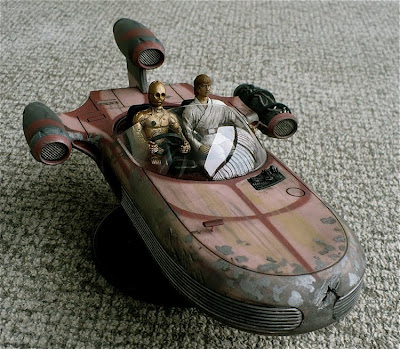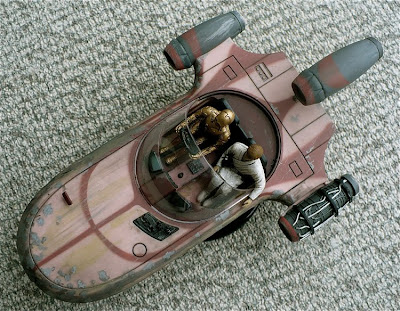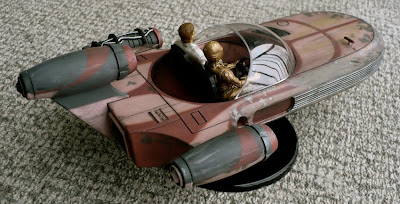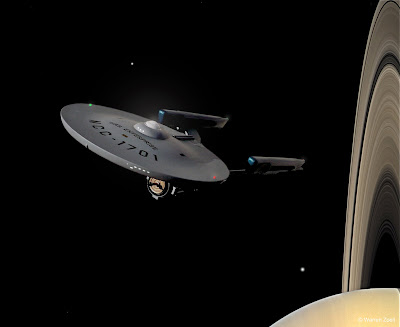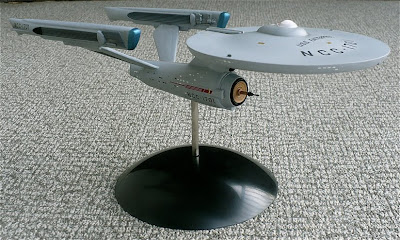

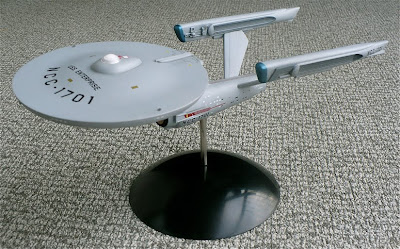
Here are some images of my 1/1000 scale kit bash of the Phase II Enterprise from the failed late 70's television program.
Looking at the interweb I've noticed that there various interpretations of what the Phase II Enterprise would have looked like if it were completed. So I figured what the heck I might as well throw mine into the mix as well.
F
rom Wikipedia"Star Trek: Phase II was a planned television series based on the characters of Gene Roddenberry's Star Trek, which had run from 1966 to 1969. It was set to air in early 1978 on a proposed Paramount Television Service (a forerunner to UPN). The series was to follow the adventures of the Enterprise crew on a second five-year mission, and be a continuation of the Star Trek franchise.
Several attempts at a Star Trek motion picture were made in the 1970s, including Gene Roddenberry's 1975 treatment The God Thing, and a later attempt called Planet of the Titans, which proceeded to script stage only to be abandoned in 1977. It was decided instead to create a new Star Trek television series, for a new national television network to be owned by Paramount. This was announced on June 17, 1977 with a projected start date of May 1978.
Pre-production work started, with sets built, several television grade models (including the Enterprise itself and many of the pilot episode's models) made, deals made to bring back most of the original series cast, and several actors cast. It was planned to use the original series uniforms. Principal photography had not started, but test footage had been shot. Story writing had proceeded to thirteen scripts, enough for a half-season.
Work on the series came to an end when the proposed Paramount Television Service folded. However, following the success of the science fiction movies Star Wars and Close Encounters of the Third Kind, the planned pilot episode entitled "In Thy Image" was adapted into a theatrical production, Star Trek: The Motion Picture.
Several minutes of test footage, including a view of a redesigned Engineering Room, costume tests with crew, screen test footage of David Gautreaux as Xon and costume test footage of Persis Khambatta as Ilia, were included in a featurette on the DVD release of the Directors Edition of Star Trek: The Motion Picture.
The series was planned to have included William Shatner and DeForest Kelley reprising their roles as James T. Kirk and Leonard McCoy. Conspicuous by his absence was Leonard Nimoy, who declined to return due to a marketing issue over the Spock character, his displeasure over Roddenberry's screening of Star Trek blooper footage at various conventions and obligations to the play Equus, although early scripts included him. Scotty, Uhura, Sulu, and Chekov were all to return, with promotions to Lieutenant Commander for Uhura and Sulu, and to Lieutenant for Chekov. Chekov would have been chief of security. The character of Christine Chapel would also return, having become a doctor since the original series, in which she was a nurse. Phase II would also have marked the return of Janice Rand to the Enterprise.
The series would have included several new characters, such as Commander Willard "Will" Decker, the Executive Officer, Lieutenant Ilia, and the Vulcan Lieutenant Xon.
According to the series bible, Xon was to be a full Vulcan, and unlike Spock, fresh out of the Academy at 22. Doctor McCoy was to have been protective about him. The character of Xon did not appear in The Motion Picture, although David Gautreaux had been cast in the role. When Leonard Nimoy finally agreed to reprise Spock, his Vulcan replacement as Science Officer became Commander Sonak, and appeared briefly in the film; after only a few lines of dialogue, he was killed in a transporter accident. This was to preserve Xon, and the actor who had so carefully developed him, for a possible future production. David Gautreaux made a cameo appearance in the movie as a human, Epsilon 9's Commander Branch.
The concept of the brilliant young Vulcan scientist, Xon, almost survived into a later movie. One premise developed as a possible sequel to the first movie included a male Vulcan called Doctor Savik. A variation of that name, Saavik, was later given to a female Vulcan when elements of several premises were combined for Star Trek II: The Wrath of Khan, and elements of Xon, such as his search to understand humans, would be transferred later into the character Data on Star Trek: The Next Generation. Also, the concept of a full-blooded Vulcan dealing with humans is explored with T'Pol on Star Trek: Enterprise.
Wil Decker is established in the show as coming from a long line of Starfleet officers. The early script notes that he was the son of Commodore Matt Decker, who had been featured in "The Doomsday Machine" (an episode of the original television series), and would "command some landing parties", anticipating the TNG situation where the first officer usually took down away teams. The role of Decker remained uncast until after the film project officially began, at which time Stephen Collins was cast.
Lt. Ilia, a Deltan, is established as an empath. Both the Decker and Ilia characters appear in The Motion Picture, although neither of them survive it. The Motion Picture establishes that Decker and Ilia had a pre-existing relationship. Persis Khambatta was cast as Ilia for Phase II and was carried over onto the film. The TNG characters William Riker and Deanna Troi are derived from Decker and Ilia. A number of screen-test shots of Persis Khambatta in Ilia makeup were taken, as well as footage of costume tests.
Two scripts for the series ("The Child" and "Devil's Due") were rewritten for use in Star Trek: The Next Generation.
Several episodes of Star Trek: Phase II were scripted:











